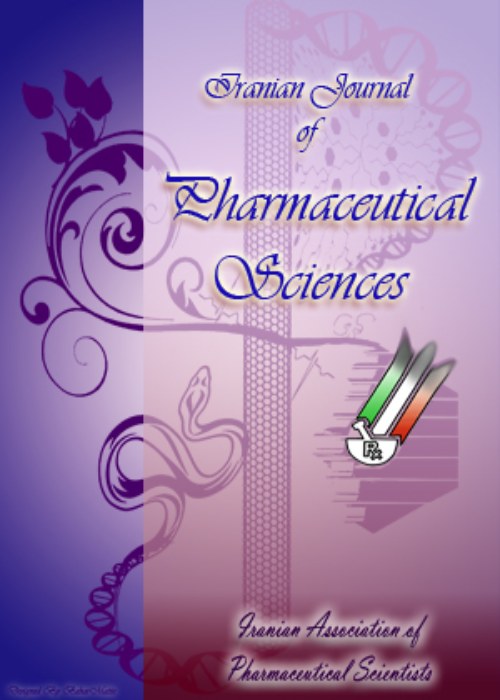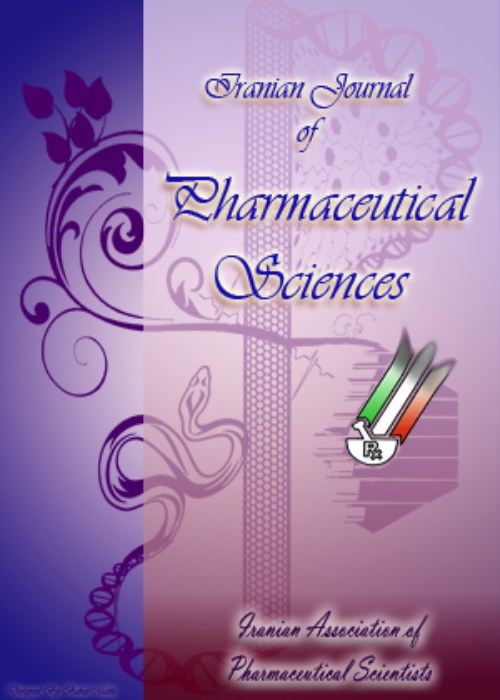فهرست مطالب

Iranian Journal of Pharmaceutical Sciences
Volume:19 Issue: 2, Spring 2023
- تاریخ انتشار: 1402/08/01
- تعداد عناوین: 8
-
-
Pages 88-98
Laccase enzymes are widely used in industrials and therefore achievement to the resources of this enzyme with high thermostability is obligatory. Accordingly, a deeper investigation for understanding the structure and function of PoxA1b from Pleurotus ostreatus, as a fungal enzyme with the possible desired conditions, was accomplished by using in-silico methods. Our study led to modeling a tertiary structure of the enzyme with 72% identity to the laccase from Trametes sp. AH28-2, with high quality. Moreover, structural stability of modeled enzyme compared to laccase from Pycnoporus cinnabarinus (LPC), were proved during 20 ns at 300 and 333K. Interestingly, this data showed that the modeled enzyme is more stable than LPC at 333 K. On the other hand, interaction assay of PoxA1b and LPC with benzo[a]pyrene (BaP), as a Polycyclic aromatic hydrocarbons (PAHs), revealed suitable affinity for both of them with -9.1 and -8.8 of binding energy, respectively. Taken together, these data show that both laccase from Pleurotus ostreatus and Pycnoporus cinnabarinus are stable until 60 °C with suitable affinity to substrate. Bearing in mind, PoxA1b is a favorable candidate for industrial and environmental applications, especially in PAH detoxification.
Keywords: Enzyme activity, PoxA1b, Stability, PAHs, Molecular simulation -
Pages 99-109
Based on estimates, the skin reactions caused by radiation therapy in women with breast cancer range from 87 to 96%. Since the purpose of complementary and alternative medicine in nursing care is to alleviate suffering and increase patient comfort, the researchers decided to evaluate the medicinal properties of Avena sativa L. and the effectiveness of Avena sativa L. cream on skin problems caused by radiation therapy in women with breast cancer. In this clinical trial, 66 patients with breast cancer were divided into two groups: the intervention and the control group. From the beginning to the end of the radiation therapy, the Intervention group was treated with creams containing extracts of Avena sativa L. applied locally and three times a day, and the control group used cream lacking Avena sativa L. extract. The degree of skin problems, erythema, and dry and moist desquamation in the special intervals in both groups were evaluated. The study results revealed no significant difference in the degree of radio dermatitis in both groups. However, clinically, the incidence of dry desquamation in the intervention group is lower than in the control group but statistically insignificant. There was no significant difference between the two groups with moist desquamation and mild and bright erythema incidence.
ConclusionThe results showed that local products made with Avena sativa L. extract can be used in radiation-induced skin reactions such as dry desquamation, and it is very effective. Therefore, further studies with larger sample sizes are recommended to prove this.
Keywords: Avena sativa L., Breast cancer, Desquamation, Erythema, Radiation therapy, Skin problems -
Pages 110-123
The present study aimed to evaluate the anthelmintic activity of various extracts of Rostellularia quinquangularis (R. quinquangularis) against adult Indian earthworms (Pheretima posthuma). Petroleum ether extract (PERQ), ethyl acetate extract (RQEA), and ethanol extract (RQEE) of R. quinquangularis were tested at different concentrations (10, 20, 50, and 100 mg/mL), along with the positive control (albendazole) and negative control (normal saline). Anthelmintic activity was assessed based on the duration of paralysis and mortality. The RQEE extract showed significant anthelmintic activity, with the highest activity observed at a concentration of 100 mg/mL, exhibiting paralysis time of 1.62 min and death times of 19.9 min, compared to the standard albendazole. Further, HR LC-MS analysis of the RQEE extract revealed the presence of various phytoconstituents based on m/z signals. Molecular docking analysis using AutoDock Vina indicated that Columbianetin, Dunnione, Cryptochlorogenic acid, Gaylussacin, Luvangetin, and Albendazole showed docking scores of -8.1, -7.9, -7.4, -7.3, -7.2, and -6.8 Kcal/mol, respectively. These results suggest that R. quinquangularis possesses potent anthelmintic activity, supporting its traditional use in medicinal practices.
Keywords: Rostellularia quinquangularis, Anthelmintic, Insilico, Invitro, LC-MS, Extraction -
Pages 124-138
Paraquat (PQ)-induced acute lung injury (ALI) remains a public concern due to its high mortality. Andrographolide (Andro) has anti-oxidative and anti-apoptosis properties. However, the role of Andro in ALI is still unknown. Herein, the purpose was to explore the function of Andro and potential mechanisms in ALI caused by PQ. An animal model of ALI was established with an intraperitoneal injection of PQ at 20mg/kg. Andro was administered intragastrically for three consecutive days. A specific AMPK inhibitor named Compd C, Nrf2 gene knockout, and a specific PI3K inhibitor named LY294002 were used to clarify the possible mechanism. Results revealed that Andro alleviated PQ-induced histopathological changes, including congestion, hemorrhage, destroyed alveoli, and extracellular matrix deposition, and inhibited apoptosis. Andro up-regulated the p-AMPK/AMPK ratio and Nrf2 and HO-1 levels while decreasing p-PI3K and p-Akt levels. In vitro, Andro appeared to reverse the PQ-induced reductions in SOD and CAT. However, Andro weakened the capacity to promote Nrf2 with Compd C and the capacity to reduce MDA and ROS while increasing SOD and CAT after the Nrf2 gene was knocked out. Additionally, Andro mitigated apoptosis by elevating the Bcl-2/Bax ratio. Results also showed that Andro promoted the Bcl-2/Bax ratio to reduce apoptosis with LY294002. In conclusion, Andro reduces the PQ-induced ALI through the AMPK/Nrf2 and PI3K/Akt pathways. The possible mechanism involves an antioxidant capacity to activate the AMPK/Nrf2 pathway and cause anti-apoptosis suppression of the PI3K/Akt pathway.
Keywords: Andrographolide, Acute lung injury, Paraquat, AMPK-activated protein kinases, Phosphatidylinositol 3-kinases, Mechanism -
Pages 139-155
Eucalyptus essential oil (EO) has significance economically since it is used in the medicinal and fragrance industries. The main objective of this study was to investigate the differences in yield, composition, antioxidant capacity, and antibacterial effectiveness of the EO extracted from Eucalyptus camaldulensis leaves. To achieve this, three distinct extraction techniques, namely steam distillation (SD), hydro distillation (HD), and superheated steam distillation (SHSD), were utilized to isolate the EO. The study aimed to analyze and compare these parameters among the three extraction methods. Based on the findings from the experiments, it has been found that using SHSD resulted in a higher EO yield than conventional techniques, and this SHSD produced a greater amount of EO in a shorter time. The EOs extracted using all three techniques have 1,8 cineole as the main constituent, according to gas chromatography-mass spectrometry (GC-MS) analysis results. All of the EOs demonstrated significant antioxidant capacities when tested in vitro using a variety of antioxidant assays. The EOs extracted through HD showed greater antibacterial activity among the other extraction processes, as evaluated by agar well diffusion and resazurin microtitre-plate assays. In conclusion, SHSD is more efficient for extracting EOs and antioxidant activity than traditional HD and SD.
Keywords: Superheated steam distillation, Eucalyptus camaldulensis, Essential oil, 1, 8 cineole, Antioxidant activity, Antibacterial activity, Hydro distillation, Steam distillation -
Pages 156-165
Clotrimazole is a broad-spectrum antifungal drug within the imidazole group that can potentially disrupt fungal cell ergosterol synthesis. It is a lipophilic molecule with a slow dissolution rate in water and poor aqueous solubility. Many efforts have been made in the literature to enhance clotrimazole’s solubility. Herein, with the aim of solubility enhancement, the solubility profile of clotrimazole in the aqueous binary mixtures of N-methyl-2-pyrrolidone at temperatures ranging from 293.2 to 313.2 K was investigated. The experimental solubility values were enhanced by increasing cosolvent composition and temperature. Furthermore, four mathematical cosolvency models were applied to correlate the solid-liquid equilibrium data, and the model accuracy results were shown as the mean relative deviation. Additionally, density values of saturated clotrimazole solution in the studied binary system were determined and reported. Gibbs and van’t Hoff equations were also employed to compute dissolution thermodynamic parameters at Thm=303 K.
Keywords: Clotrimazole, Binary mixtures, Thermodynamic parameters, Solubility, Mathematical modeling, Cosolvency -
Pages 166-175
The Lamiaceae family of plants includes Salvia macrosiphon, one of the therapeutic plants. In Iran, S. macrosiphon seeds are used as a remedy to prevent or treat numerous diseases. The chia seed, also known as Salvia hispanica, has beneficial effects on human health. This study examines the chemical composition and nutritional value of S. macrsoiphon seeds. In some previous research, S. macrosiphon seeds components were compared with Salvia hispanica's. In February 2021, S. macrosiphon seeds were bought from an herbal market; after they were authenticated, seed oil was obtained, and its chemical constituents were examined. S. macrosiphon seeds contain the following nutrients per 100 g: calcium 0.47 g, phosphorus 0.186 g, magnesium 9.75 g, moisture 5.2 g, ash 5.55 g, crude protein 18.92 g, crude fiber 22.2 g, carbohydrates 4.49 g, starch 17.25 g, total fiber 53.04 g, ADF (acid detergent fiber) 23.0 g, ADL (acid detergent lignin) 9.75 g, S. macroiphon seeds have 58.5059 calories total energy per gram. Fatty acids abound in S. macrosiphon oil, particularly linolenic (38.7%) and linoleic (24.5%) acids. Analysis and comparisons reveal that the chemical components obtained from S. macrosiphon and S. hispanica seeds are strikingly similar in quantity.
Keywords: Salvia macrosiphon, Chemical composition, Nutritional value, linoleic acids, crude protein, crude fiber -
Pages 176-187
Ketosis and attenuation of low-grade inflammation have been reported after consumption of sodium-glucose cotransporter-2 (SGLT2) inhibitors, but their mechanism and metabolic consequences have not been clearly defined. This clinical trial study aimed to assess SGLT2 inhibitor-induced ketonemia and its association with metabolic profiles and interleukin 6 (IL-6) levels in patients with type 2 diabetes mellitus (T2D). Biochemical variables, including fasting blood sugar (FBS), beta-hydroxybutyrate (BOBH), uric acid (UA), phosphate, insulin, glucagon, adrenocorticotropic hormone (ACTH), cortisol, and IL-6, were measured in 77 patients with T2D before and one month after treatment with empagliflozin (38 patients) and compared with a matched control group (39 patients). The patients in the intervention group received metformin and 10 mg empagliflozin, while those in the control group received metformin alone. The results revealed a significant decrease in IL-6, UA, FBS, glycated hemoglobin (HbA1C), body mass index (BMI), blood pressure, and the homeostasis model assessment–estimated insulin resistance (HOMA-IR) index after one month in the intervention group. However, the BOHB concentrations were significantly higher only in the empagliflozin recipients (p=0.040), with no symptoms or signs of ketoacidosis. Despite the increase in the concentration of BOHB, no significant difference was observed regarding insulin, glucagon, ACTH, and cortisol levels before and after taking empagliflozin. Besides, both groups observed a positive correlation between BOHB and UA levels (r=0.680, p=0.0001 in the empagliflozin group and r=0.646, p=0.002 in controls). Nevertheless, HOMA-IR and UA concentrations decreased significantly only in the intervention group (p=0.020 and p=0.011, respectively). At the end of the study, IL-6 levels showed a significant reduction within the groups and more in the intervention group compared to the controls. IL-6 levels were positively correlated to HOMA-IR (r=0.401, p=0.013) in the intervention group, but no relationship was detected between IL-6 and BMI, BOHB, UA, and insulin concentrations in the two groups. Based on the results, SGLT2 inhibitor-associated ketonemia was independent of changes in the insulin, glucagon, or cortisol levels. However, low-grade ketosis was associated with improved insulin sensitivity. The results also suggest that SGLT2 inhibitors possess anti-inflammatory activity, possibly mediated by their ability to reduce insulin resistance.
Keywords: Beta-hydroxybutyrate, Empagliflozin, Homeostasis model assessment–estimated insulin resistance index, Interleukin 6, Type 2 diabetes, Uric acid


